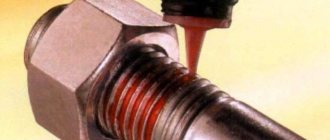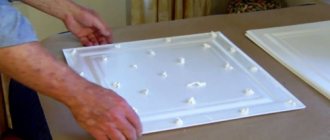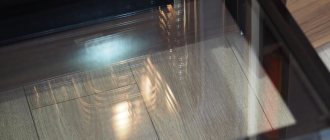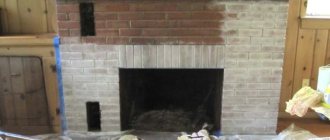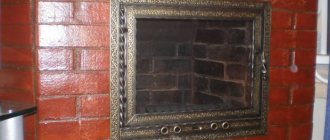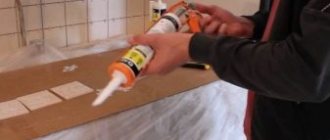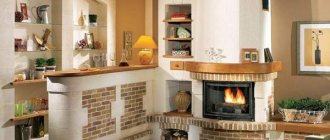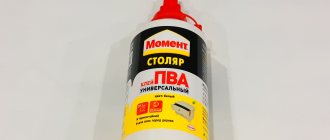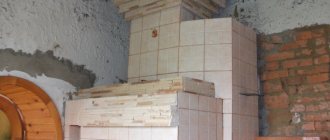Criteria for choosing adhesive
You should choose adhesive for fireplaces and stoves according to several criteria.
Let's look at this issue and decide what exactly can influence the choice of this material. So: The location of the fireplace and stoves, which can be indoors or outdoors. Keep in mind that heat-resistant adhesive for stoves and fireplaces can withstand temperatures up to 120°C. Therefore, this material can be used for lining furnaces.
But there is one detail here. When purchasing, you should also pay attention to the lower temperature limit. When outdoors, for example in a summer kitchen, the liquid must withstand low temperatures. It is also favorable to tolerate temperature changes in the off-season.
Before purchasing, the instructions for use must be fully studied. For lining the firebox, it is necessary to select a fire-resistant adhesive composition. The choice should also be made based on the type of finishing material. A specific adhesive may be intended for different elements. You should immediately pay attention to the material that was used to decorate the fireplace. Not every foundation can fit it. It is not always possible to use heat-resistant adhesive for finishing stoves, since this composition is applied to the tiles only in a thin layer. Therefore, you should look at the differences in the plane. If there are a large number of them, you should choose a thicker heat-resistant composition so that unevenness can be smoothed out. You should also pay attention to water and vapor tightness. If there is a stove for a bath, then this will be one of the main requirements.
This glue can be divided into two types. This is determined by its chemical composition:
- Heat-resistant synthetic glue;
- Heat-resistant natural glue.
Ten high-quality adhesives for porcelain tiles
KM 25 reinforced
It is produced on the basis of cement, to which polymer plasticizers are added. Thanks to this quality, the products will not dry out within 20-25 minutes. This is quite enough for even a not very experienced master to correctly lay both small and large porcelain tiles. The glue itself is inexpensive - it is one of the cheapest options in our review. The product is universal because it can be used not only when working with porcelain stoneware, but also with ordinary ceramic tiles of increased weight.
More: TOP 10 thermostats for heated floors
The adhesive is intended for both interior and exterior use. It can easily withstand even significant loads, so it is used even for high-traffic areas. The quality is excellent - it literally connects tightly to the subfloor. Suitable for heated floors, hardens completely within 24 hours, works with products whose dimensions do not exceed 40x40 cm.
Advantages:
- Low cost;
- Withstands even significant loads with ease;
- Easy to use;
- Suitable for outdoor use.
Flaws:
- Cannot be used on wall tiles.
Adhesive KM 25 reinforced
Ceresit CM 14 Extra
Another fairly cheap product that manufacturers recommend using in the process of installing ceramic finishing materials up to 50x50 cm in size. The versatility of the glue is as follows: it can be used for absolutely any type of tile, gluing wall tiles. It withstands moisture and low temperatures very well, which is why the adhesive is also used for outdoor work.
When diluting the glue, carefully follow the manufacturer's instructions. Only in this case will it be possible to achieve the highest possible quality. It is very convenient to use - the tiles will not slide off the walls. The glue does not release toxic or simply harmful substances into the environment, so it is absolutely harmless to the human body and can be used in rooms without ventilation. Experienced tilers claim that the glue has excellent viscosity.
Advantages:
- Very easy to use;
- Absolutely safe from an environmental point of view;
- Perfectly withstands even extremely low temperatures.
Flaws:
- The composition is suitable exclusively for non-deformable surfaces.
Adhesive Ceresit CM 14 Extra
Knauf Fliesen
Just like the two previous positions in our rating, this glue is made on the basis of cement. Many manufacturers of porcelain stoneware and ceramic tiles recommend using this particular composition. It will hold securely and firmly on any type of base. The only condition that is imposed on them is that they must be hard and dense. The composition can withstand ambient temperatures down to -50 degrees, making it recommended for use in outdoor work.
However, there are certain restrictions regarding the maximum size of glued elements. For wall products - no more than 30x30 cm, for floor products this figure should not exceed 60x60 cm. The adhesive is of high quality, has low consumption, and is applied easily and effortlessly.
Advantages:
- Recommended by many manufacturers of porcelain stoneware and tiles;
- Does not dry too quickly - there is time to adjust the position of the material;
- Easily withstands low temperatures;
- Economical consumption.
Flaws:
- Cannot be used for underfloor heating systems.
Knauf Flizen glue
Bergauf Keramik Pro
This is a very effective material that has fairly decent seam elasticity. The adhesive is perfect for gluing various types of tile finishing materials. The product allows you to ensure a decent quality of connection between the base and the tiles. The composition is intended for porcelain stoneware, natural stone, and even ordinary tiles.
The temperature range at which the glue will retain its basic performance characteristics is from -50 to +70 degrees. This makes the material suitable for working with heated floors and for facing outdoor surfaces. The glue is not afraid of moisture, so it can be used in rooms with very high humidity levels. It is not very convenient to work with thick layers; the glue hardens within a couple of minutes, dries and hardens in 20 minutes. Dries completely within 16-18 hours.
More: Top 10 best electric planers
Advantages:
- Not afraid of sudden temperature changes;
- Resists moisture well;
- Can be installed on any kind of heated floors;
- Provides an elastic seam.
Flaws:
- It is not very convenient to work with a thick layer of glue;
- It should be mixed in small portions, as the glue dries very quickly.
Bergauf Keramik Pro glue
Litokol Litoflex k80
Universal adhesive for porcelain tiles is made on a cement base. It can be used with classic ceramic tiles, natural stone and other similar materials, even with vinyl-based tiles. The adhesive is optimal for finishing bathrooms, showers, and balconies. Other products are often used for cladding terraces and building facades. The glue is quite elastic, it is characterized by high adhesion to any materials.
According to experienced tilers, working with the product is easy and simple. It tolerates moisture well, tolerates high and low temperatures and their sudden changes. No asbestos fibers are found in the composition, which makes the products absolutely safe for human health. Does not release toxic compounds into the environment. It sets securely, but not very quickly, so there will be enough time to adjust the tiles.
Advantages:
- For reliable fastening, a thin layer of glue is sufficient;
- Excellent frost resistance;
- Suitable for finishing showers, bathrooms, toilets;
- High adhesion to any substrate materials.
Flaws:
- Quite expensive.
Adhesive Litokol Litoflex k80
Mapei Kerabond T
This adhesive is perfect for attaching porcelain tiles and other fairly heavy materials, such as natural or artificial stone. The glue fits perfectly on both vertical and horizontal surfaces. If you follow the preparation and installation technology, the glue will not slip, pulling the tile along with it.
It is made on the basis of gray or white cement, and the latter will cost even more. The glue withstands prolonged exposure to moisture perfectly. They are very easy to work with because they do not begin to harden immediately after mixing. The location of the tiles can be adjusted within the next 45 minutes after gluing. The glue can be used in temperatures from +5 to +40 degrees.
Advantages:
- Excellent for working with very heavy finishing materials;
- Excellent behavior for vertical and horizontal cladding;
- There are two colors;
- Convenient to use;
- It tolerates even high humidity well.
Flaws:
- Very expensive;
- Not suitable for deformable surfaces.
Adhesive Mapei Kerabond T
Eunice Granite
You can work with this material even at subzero temperatures. The manufacturer claims that diluted glue will retain its basic performance characteristics at a temperature of -5 degrees. The basis here is ordinary Portland cement, to which special minerals and some chemical compounds are added, with the help of which the quality of the product becomes much better.
Applying the product is quite simple - the layer thickness should not exceed 1.5 cm, but even in this case it will easily hold porcelain tiles and decent-sized tiles. The composition dries in just 3 hours. After this time, he is no longer afraid of temperature changes or contact with water. The glue consumption is minimal, it is suitable for almost any substrate.
Advantages:
- Economical consumption of products;
- Dries in a short time;
- You can use glue even at sub-zero temperatures;
- Resists moisture well.
More: Top 10 hydraulic presses
Flaws:
- Not found in every hardware store.
Clay Eunice Granite
Plitonit B
In third place in our review of the best adhesives for porcelain tiles are domestic products; they have a very reasonable price and can be found almost everywhere. The composition contains special reinforcing fibers, due to which the strength of the connection between the tile and the base becomes even higher.
Mixing the composition and preparing it for work is not difficult. The glue can withstand significant temperatures from -50 to +70 degrees. This quality allows the product to be used for outdoor work. The composition is universal - it is suitable for porcelain stoneware, tiles, and artificial or natural stone. The composition is completely safe, in particular, it does not have a negative effect even on the skin of the hands. However, the composition dries completely within 3 days, and during this process the temperature must be maintained from +5 to +30 degrees.
Advantages:
- Universal composition;
- Easy to set up and use;
- Increased temperature range.
Flaws:
- There are certain difficulties when drying products.
Plitonit B glue
Litokol HyperFlex K100
Another universal adhesive composition, optimally suited for a wide variety of finishing materials; it can be used, for example, to work with heavy natural stone. This product belongs to the group of cement-based adhesives. It is quite elastic, with its help you can ensure excellent adhesion and achieve the most durable connection.
The material is white in color, so it can be used for any external and internal work. The glue contains a certain proportion of synthetic resins; they significantly increase its performance properties. This material is easy and simple to apply: it retains its plasticity for a long time. It does not thicken, which allows you to change the position of the tile. The adhesive is comfortable to apply even on vertical surfaces; it will not slip when laying heavy materials. The composition is insensitive to low temperatures and moisture. It is recommended even for work in high traffic areas.
Advantages:
- The composition does not contain harmful substances such as asbestos;
- Adhesion is very high;
- Quite elastic composition;
- The tiles will not slide during installation.
Flaws:
- It's very expensive.
Adhesive Litokol HyperFlex K100
Bergauf Granite
Our leaders were German-made glue; it is well suited even for fairly large porcelain stoneware slabs. The composition is preferred by many craftsmen and home craftsmen for a number of reasons. First of all, the glue is inexpensive, but at the same time has excellent performance properties. It is based on Portland cement; the composition can be used for cladding walls and floors even in very damp rooms.
The adhesive can be used for outdoor use, as it can withstand high and low temperatures and easily tolerates humidity. The composition retains its key positive qualities for a long time if it is operated in the temperature range from -50 to +70. The glue consumption is insignificant, it dries completely within 24 hours.
Advantages:
- Suitable for outdoor use and for finishing wet rooms;
- Acceptable price;
- Low product consumption;
- Increased level of adhesion.
Flaws:
- Not detected.
Adhesive Bergauf Granit
Glue, as an option for lining fireplaces and stoves
The fireplace must be laid in accordance with special requirements, since during operation there will be constant contact with high temperatures. Therefore, ordinary concrete solutions are not suitable in this case. It is necessary to use special ones, the composition of which will be heat-resistant, durable and at the same time elastic, since when heated, all components increase their shape, and when cooled they must return to their original state, without cracks or destruction.
Indicators of properties of refractory masses
When laying tiles and fireplaces, specialists use heat-resistant clay mortar. Chamotte is a fireproof type of clay, which is the main component of the mixture; in addition to it, there is sand, cement, synthetic plasticizers, and water.
This composition is used for brick or stone masonry, but it is not entirely convenient for cladding, since when applied to a horizontal surface it begins to slide and hardens for quite a long time. This can lead to asymmetrical lines and thick seams, which will ruin the appearance of the fireplace. Therefore, the use of special glue is recommended for cladding.
How to Carefully Apply Heat Resistant Sealant
To make it convenient to repair a stove or chimney using sealant, you need to prepare some tools and materials.
So, you will need:
- Construction mounting gun or syringe.
- Rubber spatula.
- Stationery knife.
- A gas burner and, accordingly, a refilled cartridge for it.
- Sealing compound in the cartridge.
- Masking tape.
- Latex gloves.
In the case when the paste is purchased in a tube, a construction syringe is not required, and when using a heat-resistant sealant, there is no need to prepare a burner and a gas cylinder for use.
Sealing joints between bricks requires special care
When applying sealant to surfaces, special care is required when filling seams or cracks, especially if it is necessary to maintain the neat appearance of the masonry, made “for jointing”
To carry out such work efficiently, it is advisable to take into account a couple of tips from experienced craftsmen:
In order not to stain the surface of the brickwork with sealant, a reasonable solution would be to seal it with masking tape, leaving only gaps along the line of the seams being sealed.
To prevent the sealant from getting on the surface of the brick and filling only a crack or seam, the surfaces can be sealed with masking tape of the required width. The tape is glued along the seam line, then the gap is filled with sealing paste, approximately one centimeter deep. If necessary, the sealant is leveled with a rubber spatula and there is no need to be afraid that the dark composition will stain the surface of the wall. After the paste has set, the tape is removed. This method will allow you to keep the seams in their original width and not spoil the neat appearance of the brickwork with dark paste.
The tube spout is cut so that the hole is slightly beveled, and its diameter is slightly less than the width of the seams being sealed.
You can solve this problem in another way, without using tape. To do this, when preparing the tube for work, you should not immediately cut off its spout to the maximum. In addition, the cut should be made at a slight angle and so that the hole is 2-3 mm smaller than the width of the seam - this will help control the amount of sealant squeezed out. True, with this approach there remains a risk of accidental contact of the composition with the surface of the brick, so using adhesive tape is definitely the best solution.
Having taken into account these recommendations, you can proceed directly to the process of applying the sealing composition. The work is carried out in the following order:. The first step is to cut off the sealed cap that closes the tube from the cartridge using a sharp knife
The first step is to cut off the sealed cap that closes the tube from the cartridge using a sharp knife.
This cap is cut off completely, across its entire width.
- Next, a spout is screwed onto it, which is already cut as recommended above
- The next step is to install the tube into a mounting gun, which is prepared for work in accordance with the specific features of its design.
When working with a mounting gun, you must rely on the instructions for its use - there may be differences
Next, before applying sealant to the seam, crack or gap between the brick and the cast iron part, the surface must be carefully prepared:
- Clean from dust and dirt.
— A surface that is too smooth must be treated with sandpaper to increase adhesion, and then cleaned again.
— After this, the surfaces are degreased and completely dried. To speed up this stage of work, you can use a hair dryer for drying.
Filling the seam between bricks with heat-resistant sealant
- When the surface is dry, you can begin to fill the gap with a sealing mixture.
- Further, if a heat-resistant paste was used for sealing, then it is left to dry for a while. The packaging usually indicates the exact duration of the drying period for the sealant before the next stage of work can begin. Usually this period is about a day.
After the composition has hardened according to the instructions, it is recommended to burn it with a gas burner flame
The final step is firing the hardened layer of sealant using a portable gas burner. After such treatment, the material will be able to withstand temperatures of up to 1500 degrees during operation.
Of course, only one of the commercially available sealants was shown as an example. For other compositions, there may be some differences in application technology. In any case, you must carefully study the instructions supplied by the manufacturer.
Glue for laying the base of the fireplace
Mixtures for fireplaces mainly contain clay and cement; they are less plastic, which is why their use for cladding is not recommended. This mixture is best used for laying fireclay bricks, since they are similar in composition, which means they will behave the same during heating.
This effect is called linear expansion; under the influence of high temperature, all substances change shape - they expand, and after cooling they narrow to their original position. If the composition is the same, then the percentage of expansion/contraction will be the same, and the likelihood of cracks will decrease.
How to make it yourself?
Experts identify several types of hot-melt adhesive that you can make yourself at home. They all have different compositions and properties.
Clay composition
This solution includes filler, water and clay. Most often, clay hot melt adhesive is used for the construction of stove structures.
It is practically not used for cladding. This is due to the effect of high temperature on the structure of the clay, which in this case causes cracks.
To prevent the destruction of the material, you can use fillers in the form of wood chips, sawdust or sand.
Experts note that the most effective material is ordinary sand.
The composition of the mixture depends on the degree of fat content of the clay used, which, in turn, depends on the amount of sand. If the sand component in the clay is less than 15%, it will turn out to be too oily. Normally, the raw material should contain 15-20% sand.
To determine fat content, you can use the following methods:
- Knead the clay in your hand. If it is oily, then the sand grains will not be felt between your fingers.
- Roll the raw material into a ball and dry it. Oily clay will become covered with cracks. If the ball retains its spherical shape, it means the raw material is thin.
The filler along with clay is added to the mixture in a ratio of 1:4 (if fatty raw materials are used), 1:25 (if lean clay is used) and 1:3 (for normal material). Its heat resistance will depend on the quantity and quality of raw materials in the mixture.
Experts advise adding a small amount of salt to clay hot melt glue.
One glass of the substance is enough for 10 liters of the finished mixture. Sodium chloride increases the moisture resistance of the working solution. In addition, the finished glue containing salt will not develop cracks.
To increase the heat resistance of the solution, fireclay powder can be added to it. This recommendation will be useful for those who will use charcoal for heating.
Cement-clay mixture
The mixture is prepared from sand (¾ part), chalk, clay and cement (¼ part each). The finished composition has high adhesive properties.
It is prepared only in dry form.
The cement is first thoroughly mixed with other ingredients without the use of clay. After this, clay pulp is added to the prepared substance.
After mixing, you can add a little liquid glass to the mass. The finished adhesive is suitable for finishing surfaces with tiles and large slabs.
To lay ordinary tiles, it is advisable to use simpler solutions based on sand, cement, clay and a small amount of salt.
Mortar
This mixture is prepared from sand and lime in a ratio of 3 to 1. The disadvantages of this hot-melt adhesive include the long-term preservation of humidity in the room where it was used.
In addition, it is not advisable to use this heat-resistant solution for installing tiles on stove structures.
If the lime mixture is applied to a lime coating, it is advisable to knock it down to prevent the newly applied layer from peeling off.
Cement mortar
The cement composition is most often used for finishing horizontal surfaces with tiled elements. When it dries, its strength becomes less than that of a clay mixture, so cement hot melt adhesive is used for finishing substrates that are not subject to regular loads.
The composition is prepared from 3 parts sand and 1 part cement. It is recommended to mix it using a construction mixer.
It should be borne in mind that the cement mortar quickly shrinks, so it must be constantly stirred.
Experts recommend adding no more than 100 g of powder to 1 bucket of solution. Laying mosaic or stone on such hot-melt adhesive can negatively affect the appearance of the future coating.
How to make a choice
Selecting the required material for construction work is a great art. To prevent excessive monetary, physical and time losses, it is necessary not only to have a good understanding of the characteristics of the product, but also to have the necessary experience in its use
When choosing a heat-resistant adhesive for tiles, you need to study the highest temperature the material can withstand, and also pay attention to the place of its application. It is also necessary to know in advance what material will be glued and its composition.
The heat-resistant adhesive composition must have the ability to dry quickly. as well as sufficient elasticity. It is also worth keeping in mind its adhesive properties.
High-quality heat-resistant tile adhesive can resist temperatures up to 120 degrees. During the drying process of the adhesive, toxic fumes will be released, so do not forget about such a parameter as toxicity when choosing a heat-resistant adhesive for tiles. This adhesive is used at fairly high temperatures, so the best choice would be a heat-resistant tile adhesive with the lowest toxicity level.
The next step in choosing an adhesive is waterproofing. A heat-resistant tile adhesive that has this characteristic will have better adhesive ability. Dried fireproof glue can only be heated 2 days after final drying.
Requirements for heat-resistant adhesive
All heat-resistant compositions meet the following requirements:
- The composition must be fire resistant, since fireplaces and stoves are constantly exposed to open fire.
- Steam and water permeability is a significant point when using a stove in bathhouses.
- Increased flexibility helps maintain structural integrity.
- Due to the content of fibers in the composition, the adhesive is used for fastening the plaster mesh.
- Temperature resistance concerns not only the maximum limit, but also the lower limit, since often fireplaces and stoves can be located in unheated rooms.
Heat-resistant adhesive for tiling stoves and fireplaces
When facing stoves or fireplaces with clinker, fireclay or other heat-resistant finishing materials, ordinary glue is not suitable.
Only heat-resistant tile adhesive should be used. This glue is produced in dry mixtures that have special chemical components that do not lose their properties when heated. Such mixtures are classified as environmentally friendly building materials that do not emit toxins during operation. Fireproof tile adhesive refers to silicates that are made on the basis of liquid glass with the addition of heat-resistant clay, kaolin, and some binding elements. This material is ready for use, it adheres well, and is easy to apply to a previously prepared surface.
Materials and tools
To cover heated surfaces you will need the following materials and tools:
- tiles in the required quantity;
- tile adhesive corresponding to the type of facing material;
- grouting mixture (in the same color scheme as the tiles);
- special crosses to control the thickness and evenness of seams between elements;
- rubber and notched spatulas;
- cutting tool;
- plumb line, level;
- metal brush;
- construction mixer;
- container for preparing the working composition.
Putty knife
Important! Everything you need for installation can be purchased at a specialized store. There you can get comprehensive advice on all issues related to cladding.
Ready-made mixtures for laying stoves
The option of independently preparing materials for a masonry mixture is the most economical, but at the same time very labor-intensive, especially when it comes to clay mixtures. Ready-made mixtures will help speed up work and avoid mistakes when preparing masonry mortar. There are many of them, but let's look at just a few:
- Emelya is an elastic, heat-resistant finished material. It is highly resistant to cracking and has almost no odor. The mixture cleans well from hands and tools. Used for ceramic and fireclay bricks. When laying the stove, the brick does not even need to be wetted, as the mixture retains moisture well.
- Terracotta is an environmentally friendly, heat-resistant, elastic mixture. It contains high-quality kaolin clay, kaolin sand and fireclay. Withstands temperatures up to 1300 degrees. The only negative is that it takes a long time to dry.
- Refractory - used for laying the internal structures of stoves and chimneys from refractory bricks. Can be used for lining the external surfaces of stoves and fireplaces with porcelain stoneware and ceramic tiles.
- Ekabud is a masonry and grouting compound for furnaces of refractory and ceramic bricks.
- Vetonit is a clay mortar intended for laying stoves and chimneys made of ceramic bricks indoors. The mixture contains clay, cement, sand and additives that improve the properties of the mixture.
The use of ready-made mixtures requires compliance with certain rules:
- While a homemade solution is mixed mainly by hand, ready-made formulations must be mixed with water exclusively using a mixer.
- Repeated mixing of the mixture after it has hardened is prohibited.
- The volume of one batch should be such that it can be used within an hour.
- The furnace must be laid at a temperature of at least 10 degrees.
- The presence of plasticizers in the mixture, which prevent the solution from drying too quickly, helps prevent the seams from cracking. Therefore, you should not warm up the furnace earlier than three days after completion of work.
- To install a chimney, you need to purchase a special mixture, which is marked accordingly on the packaging.
- If you decide to veneer the stove. then this should be done no earlier than 20–30 days after the start of intensive use.
- After the first fire, efflorescence may appear on the seams of the masonry, which can be removed after the stove has cooled with a damp cloth.
The quality of ready-made mixtures is much better than homemade ones, but their cost is quite high. For this reason, everyone chooses the option that best fits the budget allocated for the installation of the furnace.
Application
Before applying hot melt adhesive to the surface, the base must be thoroughly cleaned of dust and dirt. This will allow you to achieve maximum adhesion. Cracks, unevenness and other defects in the coating must first be repaired.
If the surface to be treated absorbs moisture well, then it must be primed in advance. Before tiling, it is advisable to briefly place the tile in water to increase its adhesion to the adhesive solution.
Hot melt adhesive is applied using a notched trowel. In this case, the layer should not be thicker than 1 cm. Tiled elements are laid on it. The tiles must be glued within 10 minutes after applying the composition.
You might also be interested in seeing - Frost-resistant adhesive for exterior use
Types of heat-resistant glue
Fireplace adhesive is a solution with a viscous texture that provides quick and comfortable bonding of decorative elements, as well as tiles. There are two types of this mixture:
- dry (it needs to be diluted);
- liquid (jelly-like).
The first option is suitable for those who do not have cladding skills. The dry mixture takes much longer to harden, so it will not deteriorate if the tile laying process takes longer. Liquid glue is not inferior in quality or any parameters, but it is less convenient for beginners. It is also worth noting that the finished mixture will cost about 2-3 times more.
Cement mixture
Simple cement mortar is mixed from sand, cement and water. The proportion depends on the brand of cement. Before adding water, cement and sand are thoroughly mixed together.
When additional ingredients are added, a complex mixture is obtained. Often, cement mortar is supplemented with the addition of lime paste. But then you need to use it quickly enough. As part of the solution, 1-3 parts of other binding materials and 6-15 parts of sand are laid to one part of cement.
Heat-resistant cement mortar is obtained by adding Portland cement and small broken bricks to a simple cement-sand mixture.
